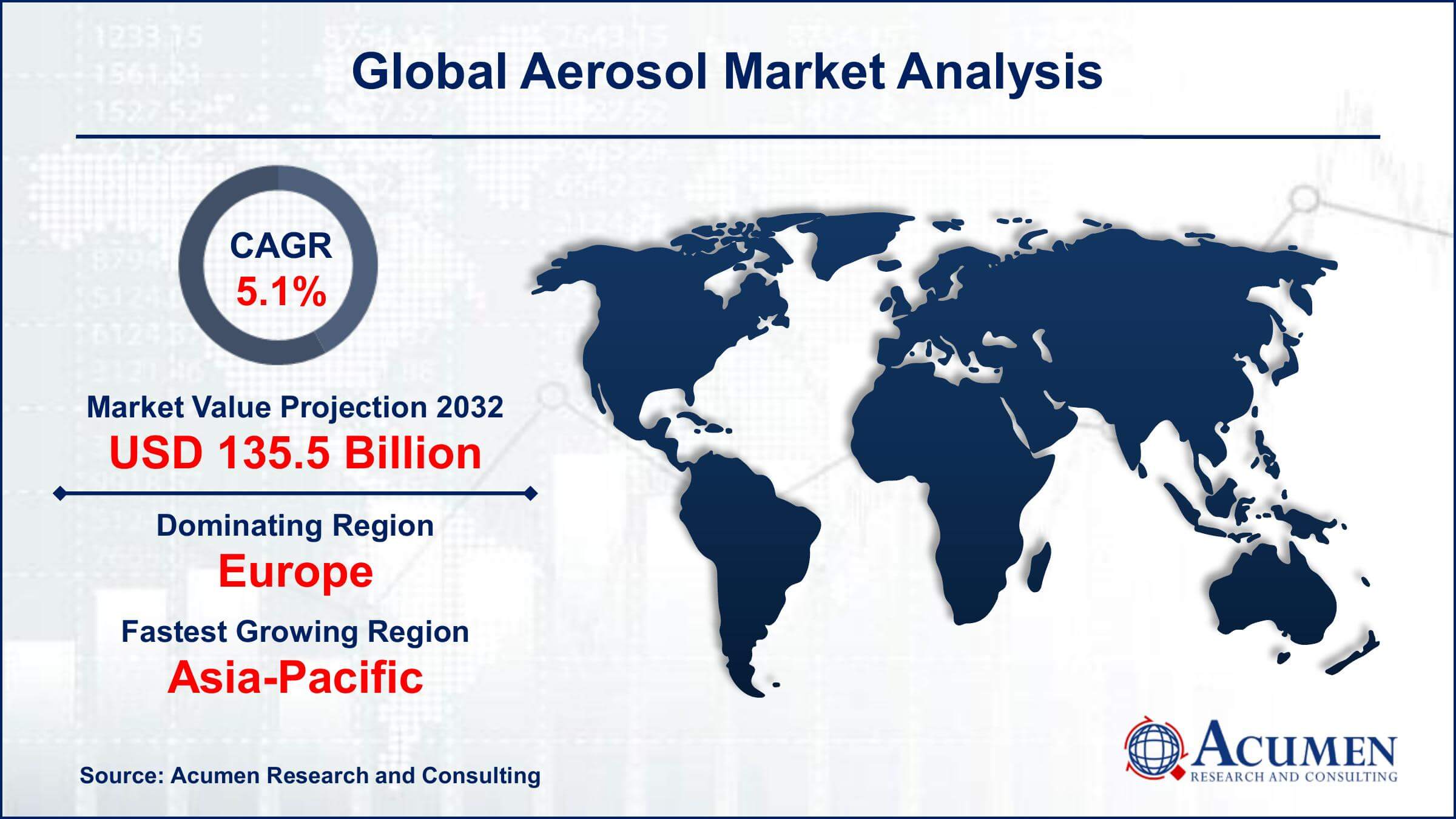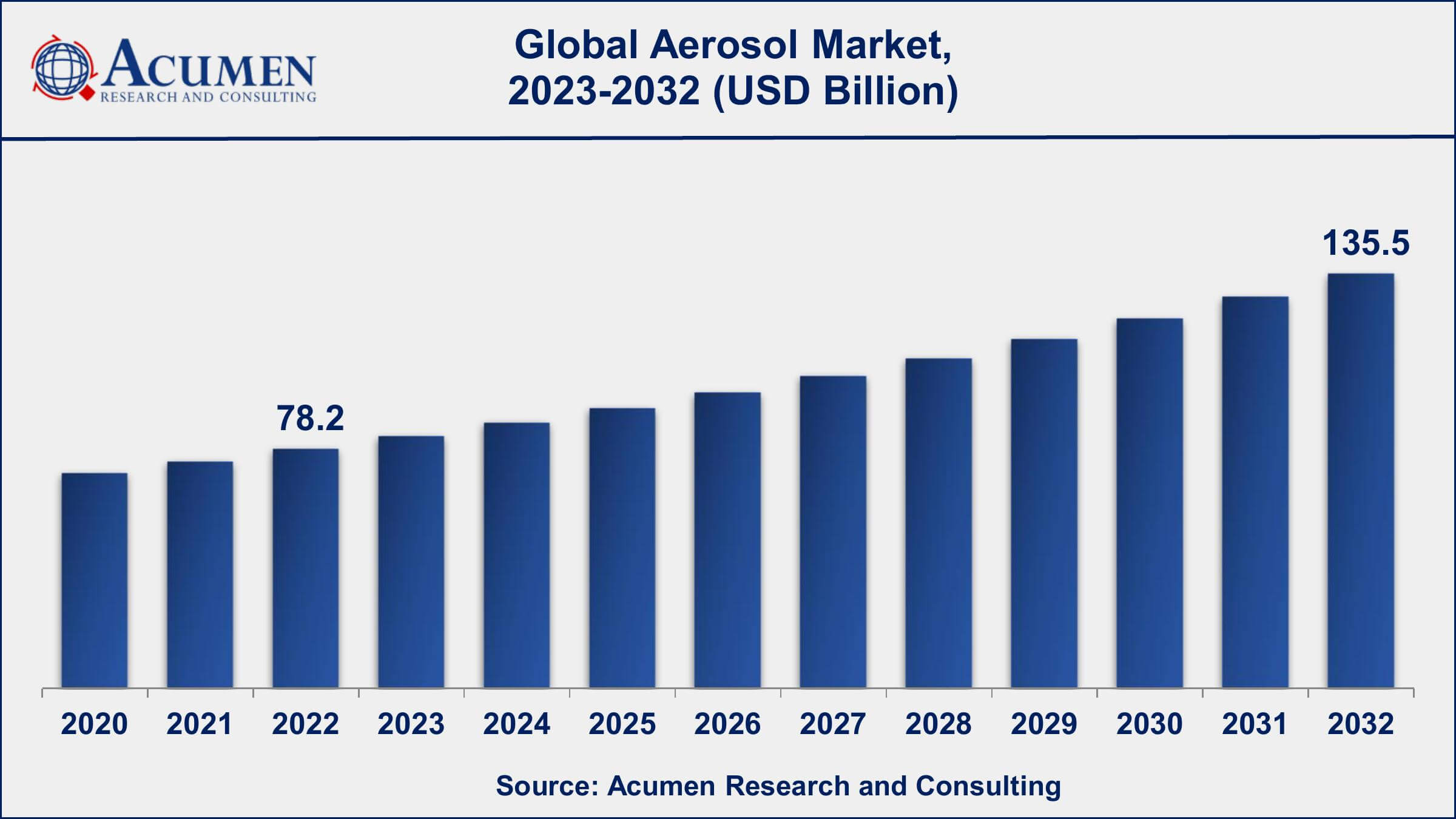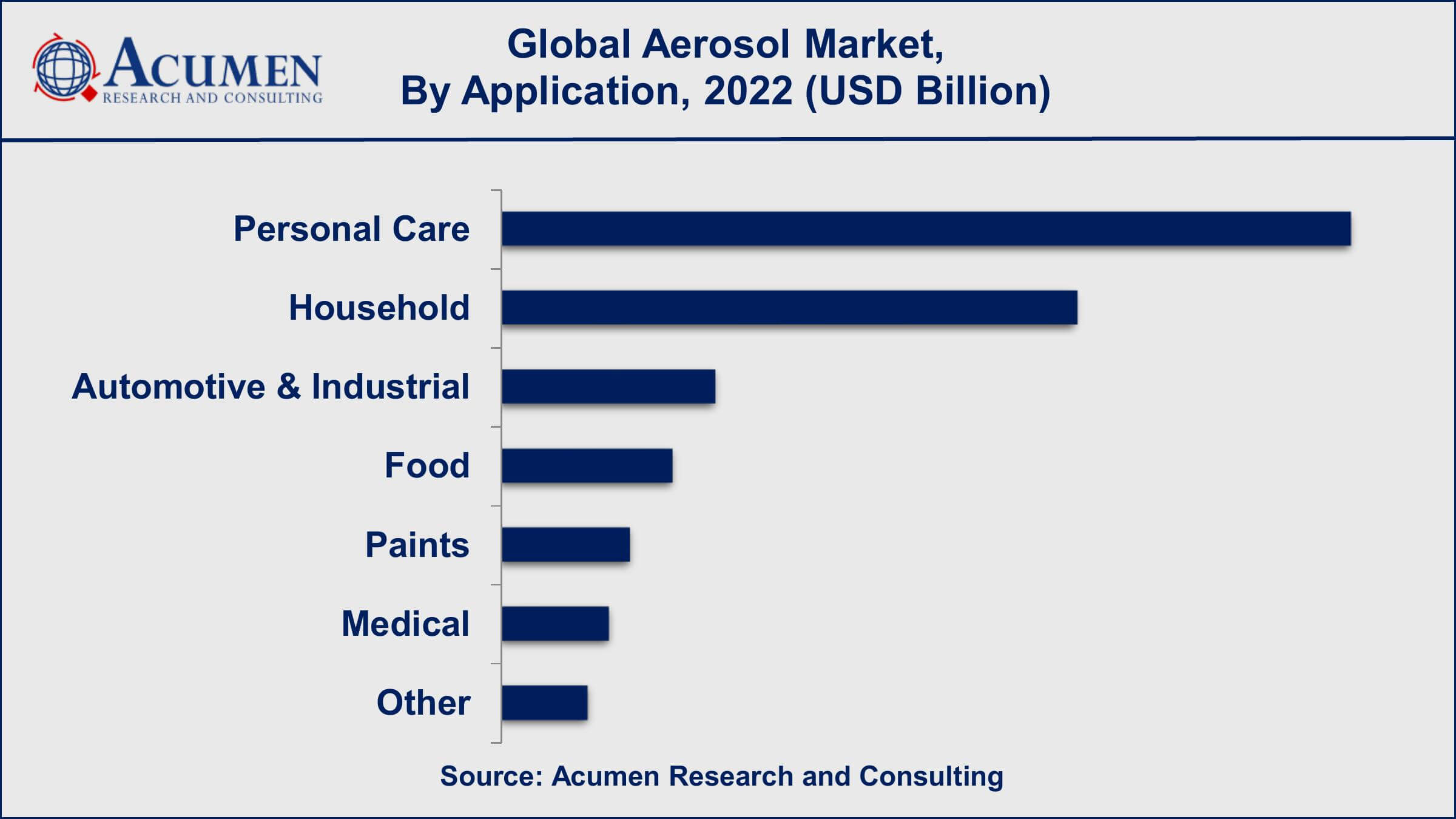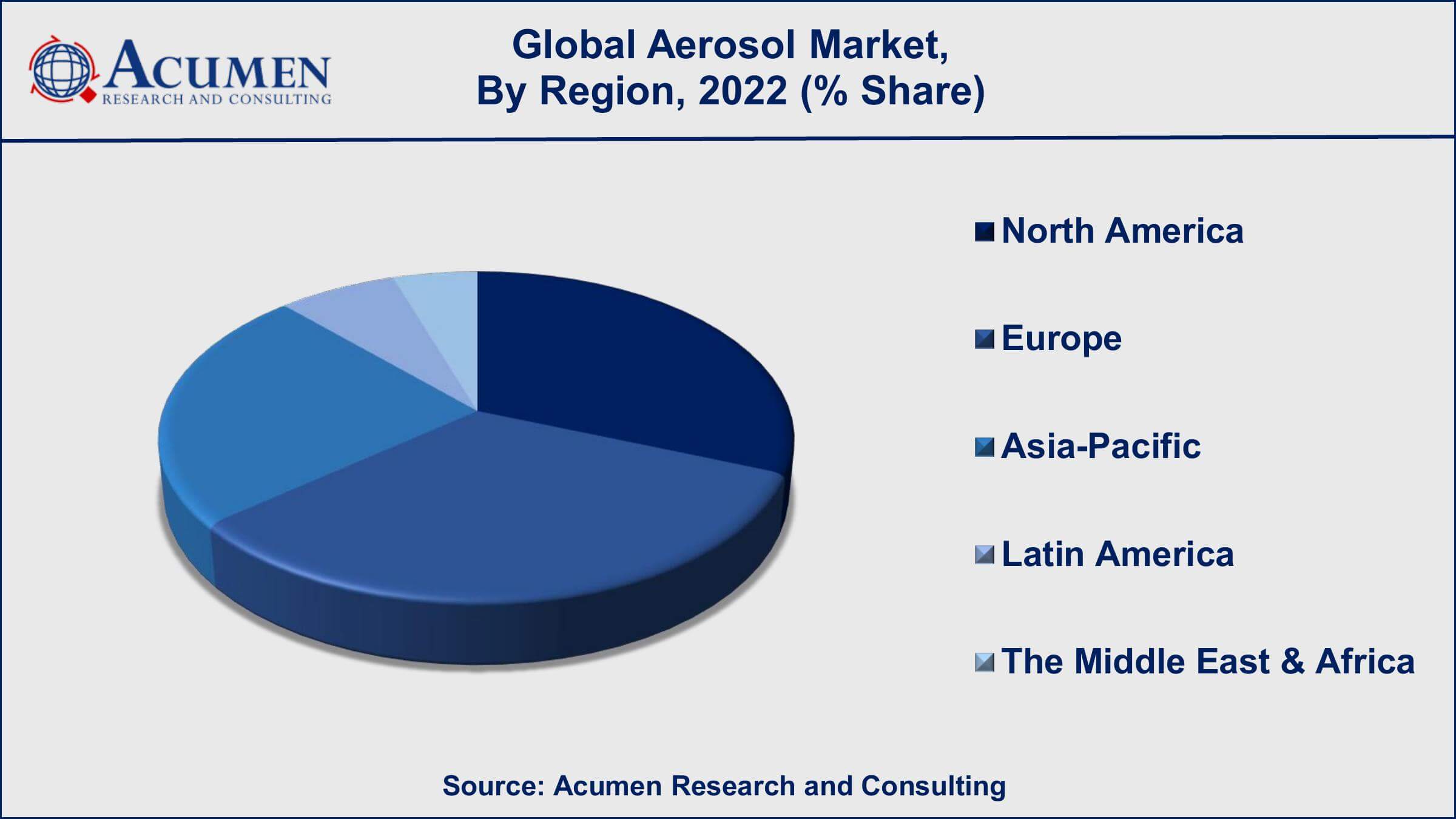October 2024
Aerosol Market Size collected USD 78.2 Billion in 2022 and is set to achieve a market size of USD 135.5 Billion in 2032 growing at a CAGR of 5.1% from 2023 to 2032.
The Global Aerosol Market Size collected USD 78.2 Billion in 2022 and is set to achieve a market size of USD 135.5 Billion in 2032 growing at a CAGR of 5.1% from 2023 to 2032.
Aerosol is a colloidal mixture of liquid droplets or solid yet fine particles generally mixed in air or gas. Aerosols can be artificial as well as natural. Natural aerosols include forest exudates, fog, geyser steam, etc. whereas artificial aerosols include dust, haze, smoke, and particulate air pollutants among others. The solid or liquid particles of aerosols have a diameter usually smaller than 1 micrometer (μm) while larger particles have a significant settling speed and make the aerosol a suspension. In general, aerosol refers to a spray that delivers a consumer product and is packed in a can or a similar type of container. Aerosols are widely used as propellants and such propellants deploy compressed or liquefied gas to propel active ingredients in paste, liquid, or powder form inaccurate spray patterns with droplet amounts and sizes controlled. Propellants find wide applications in the manufacture of shaving creams, air fresheners, hair mousse, and antiperspirants/deodorants. Moreover, aerosol propellants are also used in industrial, automobile, and technical applications.

Aerosol Market Report Statistics

Global Aerosol Market Dynamics
Market Drivers
Market Restraints
Market Opportunities
Aerosol Market Report Coverage
| Market | Aerosol Market |
| Aerosol Market Size 2022 | USD 78.2 Billion |
| Aerosol Market Forecast 2032 | USD 135.5 Billion |
| Aerosol Market CAGR During 2023 - 2032 | 5.1% |
| Aerosol Market Analysis Period | 2020 - 2032 |
| Aerosol Market Base Year | 2022 |
| Aerosol Market Forecast Data | 2023 - 2032 |
| Segments Covered | By Material, By Type, By Application, And By Geography |
| Regional Scope | North America, Europe, Asia Pacific, Latin America, and Middle East & Africa |
| Key Companies Profiled | Henkel AG & Co., Reckitt Benckiser, Crabtree & Evelyn, Thymes LLC, S.C. Johnson, Unilever, Proctor & Gamble, Royal Dutch Shell PLC, Honeywell International Inc., The Chemours Company, Arkema Group and Akzo Nobel N.V. |
| Report Coverage |
Market Trends, Drivers, Restraints, Competitive Analysis, Player Profiling, Covid-19 Analysis, Regulation Analysis |
Aerosol Market Growth Factors
Increasing demand for personal care and household products is a key factor expected to boost the demand for aerosols over the forecast period along with rapid urbanization and surge in infrastructural development across the globe. Moreover, increasing developments in emerging economies such as UAE, India, China and Thailand is another major element driving the paints and coatings industry which, in turn, is anticipated to propel the global aerosol demand during the forecast period. Increasing usage of aerosol based products in shoe polish, starch, stain removers, pre-wash sprays as well as water repellents used in fabrics and leather is another key factor fueling the growth of overall global aerosol market. Furthermore, rising demand for aerosol in several food products such as mayonnaise, vinegar, whipped cream, chocolate, ketchup, sparkling water, olive oil, soda and beer will fuel the aerosol industry growth over the forecast period. However, stringent government regulations such as regulation from the European Commission regarding the reduction of green house gas (GHG) emissions along with VOC Paints Directive are some factors expected to hamper the growth of global aerosol market in the near future. In addition, technological advancements including airless dispenser and stahl monoblock are some major elements posing vital opportunities for the global aerosol market.
Aerosol Market Segmentation
The worldwide aerosol market is categorized based on material, type, application, and geography.
Aerosol Market By Material
According to aerosol industry analysis, the aluminum segment accounted for the largest share of the global aerosol cans market, with a market share of approximately 50%. The report also predicts that the aluminum segment will continue to dominate the market in the coming years due to its growing adoption in the personal care, healthcare, and food industries. Steel is also widely used in the aerosol market, particularly for industrial and automotive applications. However, steel is heavier than aluminum and is not as easily recyclable. As a result, its use has been declining in recent years.
Aerosol Market By Type
The standard aerosol system consists of a can with a valve and a propellant, whereas the BIV system consists of a bag containing the product and a propellant that is placed inside the can. With a market share of approximately 70%, the standard aerosol system accounted for the majority of the global aerosol market. This is because the Standard aerosol system is the most widely used and has been on the market for the longest time. It is also inexpensive, simple to manufacture, and widely available. In contrast, the BIV system has grown in popularity in recent years due to its capacity to provide better protection and a longer shelf life for certain types of products.
Aerosol Market By Application

The personal care sub-segment is expected to have the highest market share from 2023 to 2032, according to the aerosol market forecast. Personal care products like deodorants, shaving foams, hair sprays, and dry shampoos are among the most popular aerosol products, especially among young people. Aerosol products have several advantages in the personal care segment, such as ease of use, convenience, and precise application, which have aided in the expansion of this market segment. Furthermore, the development of fragrances, new formulations, and packaging designs has contributed to the increased appeal of aerosol products in the personal care segment.
Aerosol Market Regional Outlook
North America
Europe
Asia-Pacific
Latin America
The Middle East & Africa

Aerosol Market Regional Analysis
The global aerosol market is witnessing intense growth and is mainly fueled by geographies such as North America, Asia-Pacific, and Europe. Vast investments are made by different key players in the global aerosol market to serve the end-users of aerosol. Aerosols are mostly used in paints and medical products in order to retain liquid in the pressurized form generally metallic cans. Various other technological applications of aerosols are the medical treatment of respiratory ailments, dispersal of pesticides, and combustion. Aerosol science encompasses technological applications of aerosols, removal, and generation of aerosols, effects of aerosol on the people and environment along with a wide variety of other concerns.
Aerosol Market Players
Some of the leading aerosol companies include Henkel AG & Co., Reckitt Benckiser, Crabtree & Evelyn, Thymes LLC, S.C. Johnson, Unilever, Proctor & Gamble, Royal Dutch Shell PLC, Honeywell International Inc., The Chemours Company, Arkema Group and Akzo Nobel N.V.
Looking for discounts, bulk pricing, or custom solutions? Contact us today at sales@acumenresearchandconsulting.com
October 2024
October 2024
July 2024
January 2025